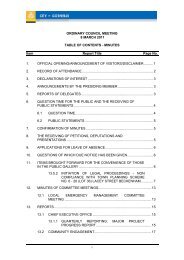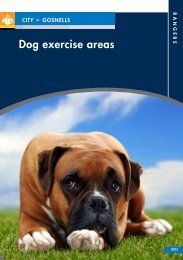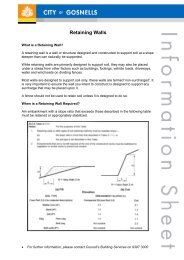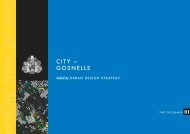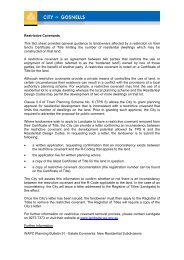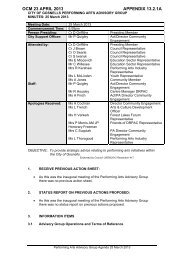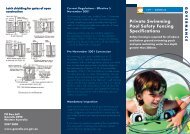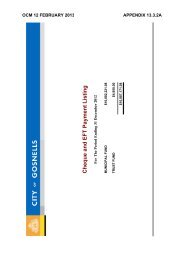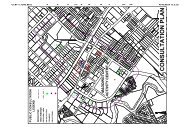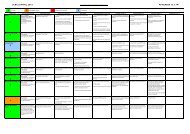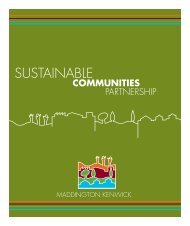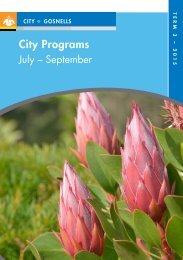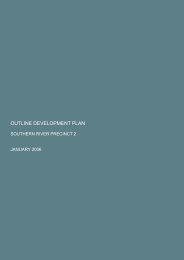Summary - City of Gosnells
Summary - City of Gosnells
Summary - City of Gosnells
You also want an ePaper? Increase the reach of your titles
YUMPU automatically turns print PDFs into web optimized ePapers that Google loves.
Wetlands Field Survey 826.2 Geomorphic classification <strong>of</strong> wetlands in the MKSEA areaThe wetlands <strong>of</strong> the MKSEA were classified in this survey according to the geomorphic system <strong>of</strong> Semeniuk(1987), in which the hydroperiod and geomorphic features <strong>of</strong> wetlands were the sole determinants <strong>of</strong> wetlandclass (regardless <strong>of</strong> wetland biota or the factors that maintain the wetland conditions). Most <strong>of</strong> the existinggeomorphic classifications and mapping <strong>of</strong> the wetlands <strong>of</strong> the MKSEA in DEC (2008a) were confirmed inthe current field survey. From the additional fine-scale data that were collected in the current survey(Appendix D) there were, however, some wetlands (Table 6.2) that may require changes to the currentgeomorphic classification. If any changes were to be made to the geomorphic classification <strong>of</strong> wetlands inthe MKSEA relative to DEC (2008a), these changes would not affect the wetland management categories <strong>of</strong>these wetlands. The wetlands involved will require detailed survey <strong>of</strong> the topography and an appropriatelydesignedground and surface water monitoring program in order to compile the data necessary for proposingchanges to the SCP Wetlands Dataset. Given the expert resources <strong>of</strong> wetland specialists to design such adetailed study, a range <strong>of</strong> pragmatic objectives that could contribute to the remediation <strong>of</strong> the hydrologicalregime and better management <strong>of</strong> the biodiversity <strong>of</strong> the area, apart from a scientifically accurateclassification <strong>of</strong> the wetlands, could be met by such a study. Some <strong>of</strong> these objectives could include acharacterisation <strong>of</strong> the processes that have been important in the development <strong>of</strong> the wetland (and thus adetermination <strong>of</strong> the baseline hydrological regime <strong>of</strong> these wetlands, prior to the widespread alteration <strong>of</strong> thecatchment) an assessment <strong>of</strong> the effects <strong>of</strong> the local drainage scheme on these wetlands and a determination<strong>of</strong> the environmental water requirements <strong>of</strong> the biota <strong>of</strong> the wetlands. In the interim, the recommendations <strong>of</strong>the current survey may be useful as a preliminary guide to inform the more sustainable management <strong>of</strong> thesewetlands and the biodiversity that many <strong>of</strong> them support.The conclusions reached about the geomorphic classification <strong>of</strong> wetlands in the MKSEA are listed below.a. Palusplains that are mapped in DEC (2008b) where no change in geomorphic classification isrecommended from the current surveyMost <strong>of</strong> the study sites surveyed in the MKSEA (Sites 1, 2, 4, 7, 8, 9, 10, 11, 12, 13, 17, 18, 19, 20, 26,28, 30, 31 and 32) were located on gently sloping to gently undulating plains that were underlain byshallow aquitards and were waterlogged in the early spring <strong>of</strong> 2007 and 2008 (Table 6.2). These areaswere all mapped as palusplains in DEC (2008b) and were confirmed as palusplains in the current fieldsurvey.Sites 1, 2 and 4 are located adjacent to Yule Brook and were floodplains before the brook was excavatedin response to the greater volume <strong>of</strong> surface flow that was initiated by clearing in the catchment area andthe need to increase the conveyance <strong>of</strong> this storm water (and water drained from superficial aquifers bydrains) via Yule Brook towards the Canning River. These floodplain areas should be restored.b. Palusplains that are mapped in DEC (2008b) where a change <strong>of</strong> classification to floodplain may beconsideredA few <strong>of</strong> the study sites surveyed in the MKSEA (Sites 3, 5, 6, 14, 16 and 21) were located on gentlyundulating plains (that occasionally included a few very small basins or channels). All <strong>of</strong> these areaswere shallowly inundated in early spring <strong>of</strong> 2007 and 2008. These areas were all mapped as palusplainsin DEC (2008b) but were considered to be floodplains on the data obtained in the current field survey.Sites 3, 5 and 21 are located adjacent to Yule Brook and were probably inundated for longer and, attimes, experienced higher standing water levels that at present. The vegetation <strong>of</strong> these floodplain areasshould be regenerated as part <strong>of</strong> a comprehensive plan to restore Yule Brook as a living stream. Sites 6,14 and 16 are located at the base <strong>of</strong> sand dunes and the wetlands there are probably partly maintained byseepage from the base <strong>of</strong> these dunes. These wetlands are currently drained by excavated channels thatexport water downslope to Yule Brook via Lot 106 Wanaping Rd or via Brentwood Rd and a drain inthe University <strong>of</strong> Western Australia Allison Baird Flora Reserve.These wetlands require protection by the reservation <strong>of</strong> an appropriate buffer zone upslope from them inthe dunes that should be revegetated and kept free <strong>of</strong> all development and infrastructure. The stormwaterfrom any developments upslope from these wetlands should be infiltrated at source to maintain seepageTauss, C. and Weston, A.S. (2010). The flora, vegetation and wetlands <strong>of</strong> the Maddington-Kenwick Strategic Employment Area.A survey <strong>of</strong> the rural lands in the vicinity <strong>of</strong> the Greater Brixton Street Wetlands. Report to the <strong>City</strong> <strong>of</strong> <strong>Gosnells</strong>, W.A. Version 18.04.10



